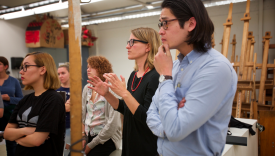Art & the History of Art 157 - The Postcolonial City
M/W | 2:00 PM - 3:20 PM
(Offered as ARHA 157, ARCH 157, and BLST 193) This course engages the buildings, cities, and landscapes of the former colonies of Africa, South Asia, and the Caribbean. Beginning with the independence of India and Pakistan in 1947, the non-European territories, which once comprised the lucrative possessions of modern European empires, quickly became independent states charged with developing infrastructure, erecting national monuments, and handling the influx of laborers drawn to the metropolises formed as sleepy colonial towns grew into bustling postcolonial cities. This class will examine the buildings, urban spaces, rural landscapes, and national capitals that emerged in response to these political histories. We will approach a number of issues, such as the architecture of national independence monuments, the preservation of buildings linked to the colonial past, the growth of new urban centers in Africa and India after independence, architecture and regimes of postcolonial oppression, the built environments of tourism in the independent Caribbean, and artists’ responses to all of these events. Some of the places that we will address include: Johannesburg, South Africa; Chandigarh, India; Negril, Jamaica; Kinshasa, Democratic Republic of Congo; and Lilongwe, Malawi. Our goal will be to determine what, if any, continuities linked the buildings, landscapes, and spaces of post-independence Africa, India, and the Caribbean in the twentieth century. Over the course of the semester, students will gain skills in analyzing buildings, town plans, and other visual materials. Also, this class will aid students in developing their writing skills, particularly, their ability to write about architecture and urban space.
Spring 2025: Professor Carey.
How to handle overenrollment: null
Students who enroll in this course will likely encounter and be expected to engage in the following intellectual skills, modes of learning, and assessment: N/A


